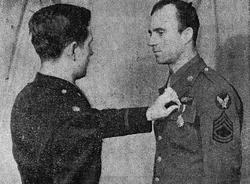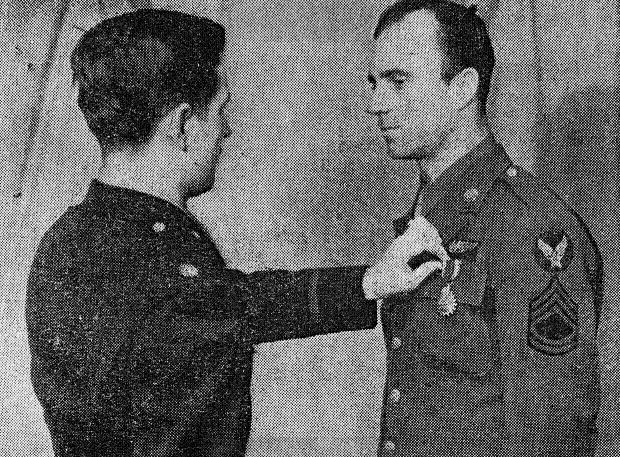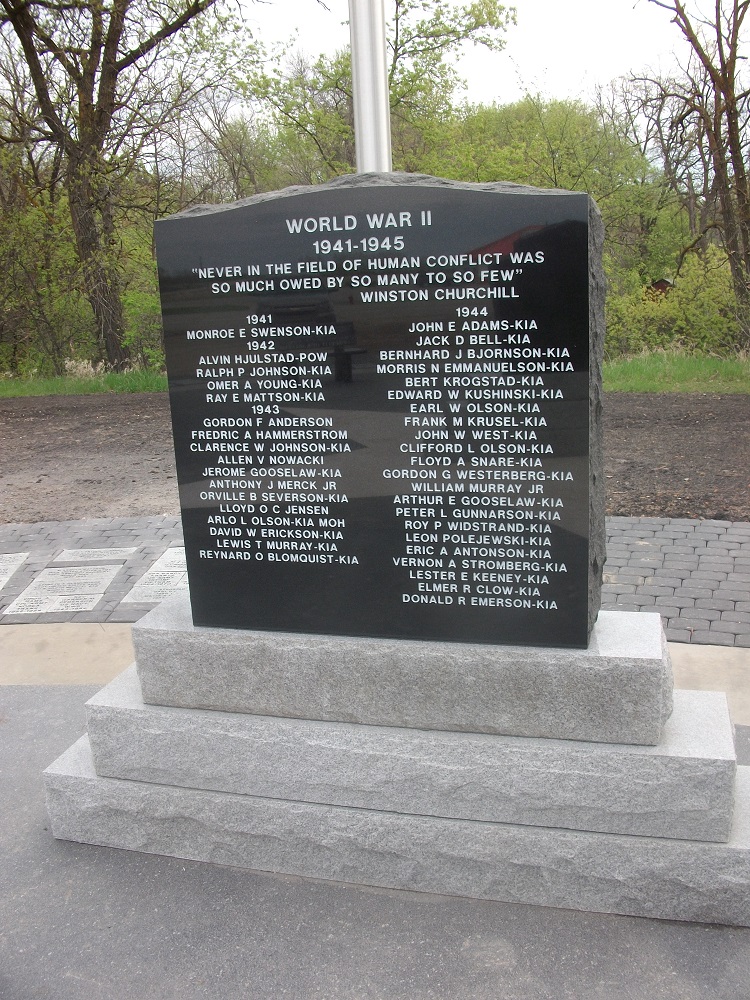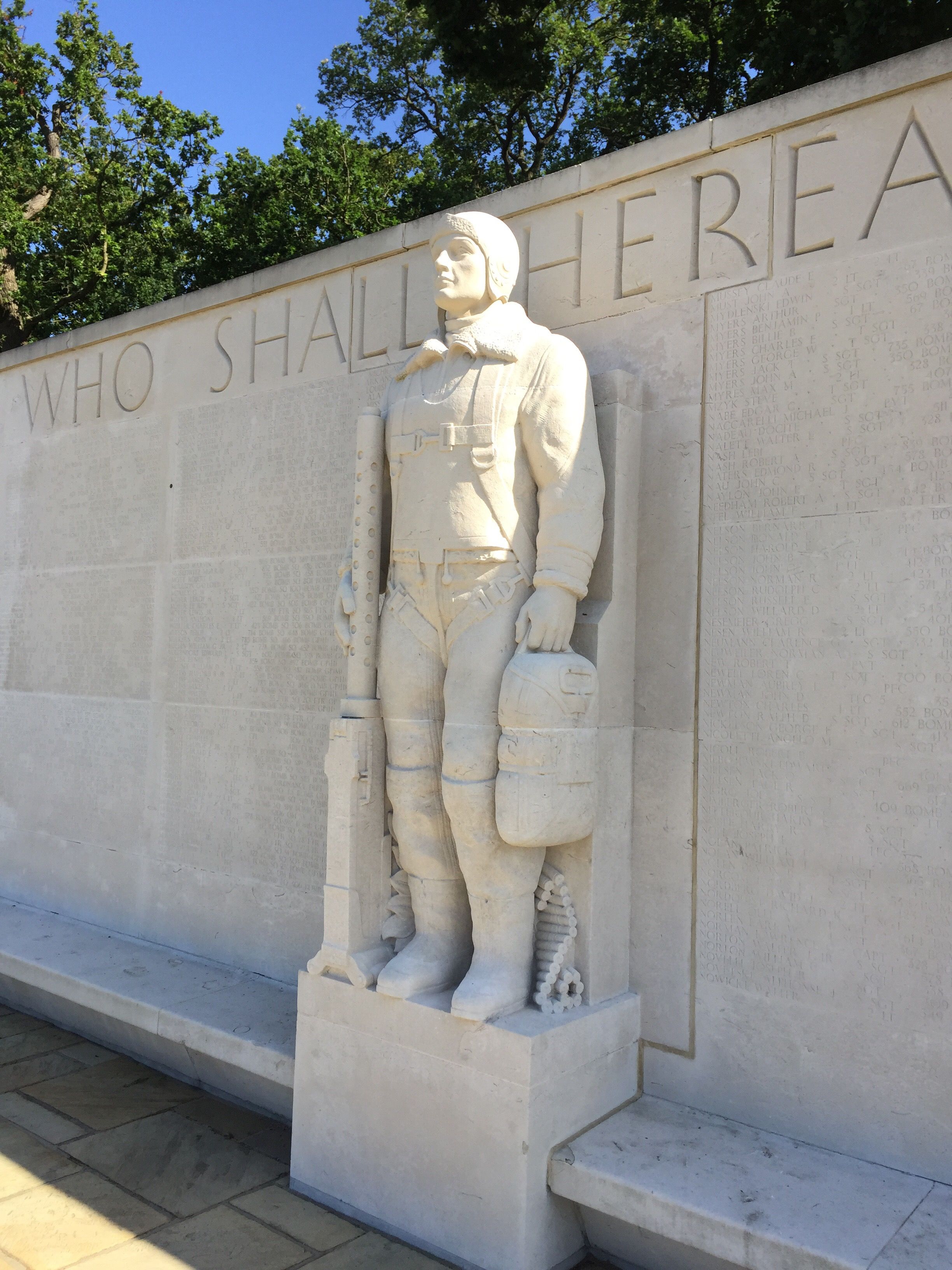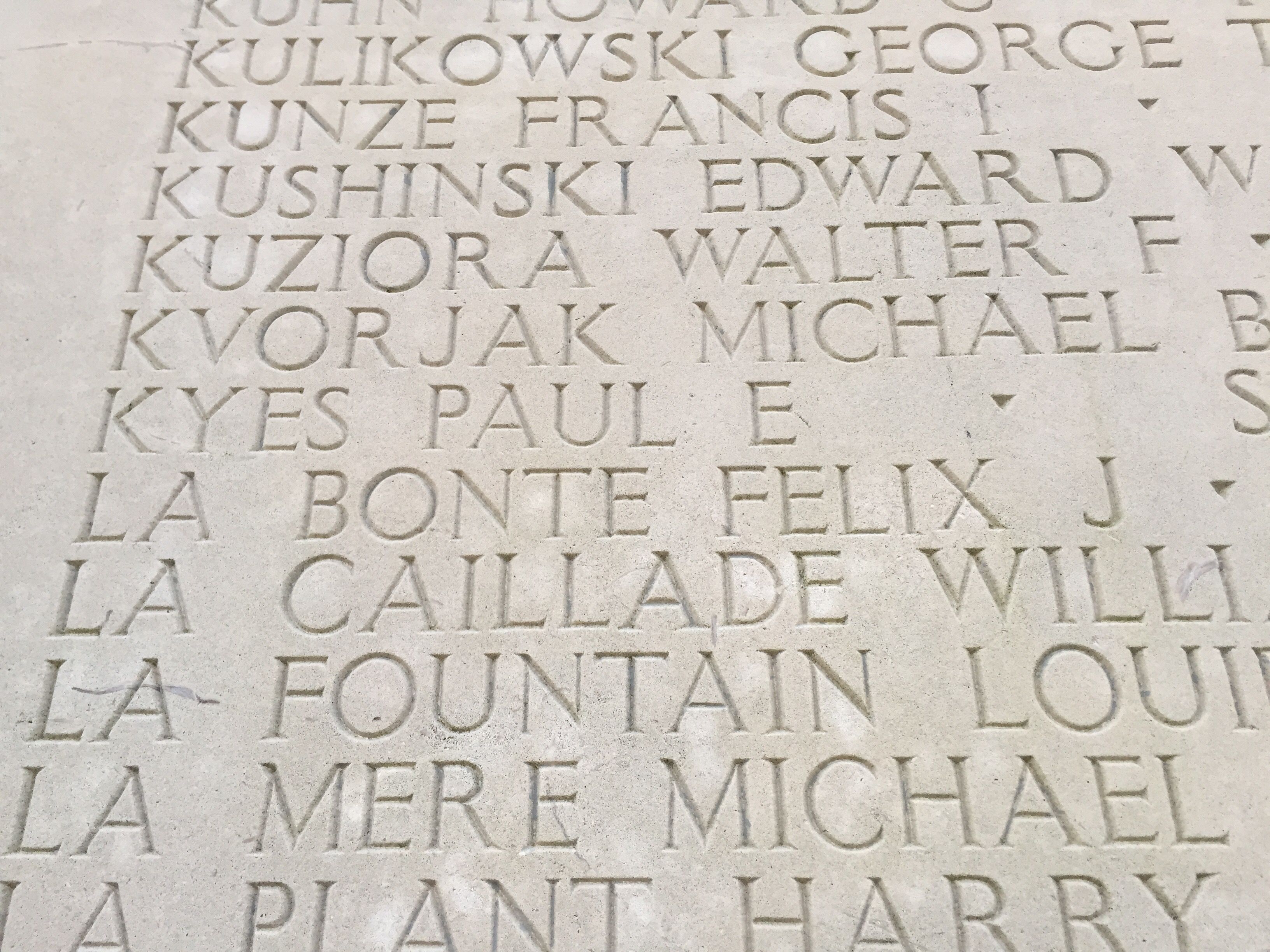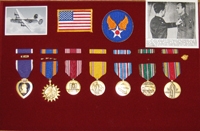---------------------------------------------------Engineer T/Sgt. Edward W. Kushinski Gunner
Hometown: Lake Bronson, Minnesota
Squadron: 68th Bomb Sq 44th Bomb Gp
Service# 16004932
Awards: Air Medal with 4 Oak Leaf Clusters, Purple Heart
Pilot 1st/Lt. Alfred D. Bonnet Injured, rescued
MACR #8250
Target: Munich, Germany
Mission Date: 11-Jul-44
Serial Number: #41-29544
Aircraft Model B-24
Aircraft Letter: C-Bar
Aircraft Name: FLAK ALLEY II
Location: Ditched in Channel
Cause: FLAK
Crew of 9 KIA - 4 Injured, rescued 5 MIA/KIA
The briefed target was Rein airfield near Munich, but heavy cloud coverage prevented visual bombing, so Munich city was bombed on a PFF assisted attack. Two aircraft were lost with one each from the 66th and 68th failing to return.
The following information was obtained from the MACR: “Ditched in Channel, four survivors. Just prior to bombs away, this aircraft was believed to have been hit by flak. #4 propeller began to run away, oil pressure dropped; consequently, the pilot (Bonnet) feathered this engine. He dropped his bombs and held formation until approximately one hour from the enemy coast. Here #2 engine oil pressure dropped and #2 prop had to be feathered.
“Lt. Bonnet left the formation and was picked up by four P-38 aircraft which escorted him. At the coast, #3 engine cut out, so he called the P-38s on Channel B of VHF and he called Colgate on distress procedure. He jettisoned as much equipment as possible, hoping to reach the English coast, but this appeared impossible. He ordered his crew to their ditching stations. He ditched!
“On hitting the water, the nose and top turret caved in and the aircraft broke apart at #6 bulkhead, with the rear section of the aircraft sinking almost immediately. The engineer was either killed or pinned by the falling top turret. The nose turret gunner McCandless, right waist gunner Butler, left waist gunner Belsky, and tail gunner Banning all drowned when the rear portion of the aircraft sank. The pilot, co-pilot, navigator and radio operator were rescued.”
The radio operator, James Garvey, wrote: “One at a time, our engines began to fail. Every 500 miles we would lose another. When we got down to one engine, and it was coughing and faltering. Bonnet and Van Dyke were trying to bring the plane down slowly.
“Four P-38s had been escorting us from the time that we left the formation. At the coast the #3 engine went out, so Bonnet ordered all unnecessary equipment to be jettisoned. When it was obvious that the plane could not make it to England, he radioed a distress signal to the P-38; and ordered the crew to assume ditching stations. The P-38 continued to circle, overseeing the ditching and fracture of the plane as it struck the water.
“When the B-24 hit the Channel, the nose and top turret caved in. The aircraft broke apart at the #6 bulkhead and the rear section sank almost immediately. Kushinski, the engineer, was either pinned or killed by the falling top turret. Butler, Belsky, and Banning all went down with the back section of the plane. The nose turret collapsed, taking Donald McCandless to the bottom.
“I was in ditch position with my back to the pilot. Kushinski lay between my legs. We hit the water so hard that the plane split in half. Kushinksi’s head struck my shoulder and fractured the bone. Part of the turret landed on him, causing his death. A piece of armor plating crashed into my 5th and 6th vertebrae, so when I was dashed into the icy water, I was helpless. The waves were eighteen feet high, but somehow the three officers were able to get the dinghy.
“I remember seeing a green translucent light above me. It was the sea. To me, there was a glimmering of hope in this lightened space. I thought, ‘I could fill my lungs with bubbles and escape this certain death.” At this point, Lt. Olsen grabbed Garvey by his epaulets. Olsen, whose leg was badly injured, still managed to pull Garvey alongside the dinghy, where he held him until help came. They were picked up by an English destroyer. Garvey had survived a bail-out only a week before with the Schaffer crew.
From a contemporary account: “Lt. Bonnet returned to base sporting a huge black eye, and Lt. Olsen, whose leg was broken, will be returned to the States. Sgt. Garvey is in the hospital and is in bad shape with a broken collar-bone and a broken leg. Looks like his flying days are over. Banning and Belsky were on their last mission and Sgt. Butler also had quite a few. There-in lay the problem. It was for this reason that they did not want to bail out and become POWs.”
FLAK ALLEY II Crew
1st/Lt. Alfred D. Bonnet pilot Injured, rescued
2nd/Lt. Thurston E. Van Dyke Co Pilot Injured, rescued
1st/Lt. Olaf W. Olsen Navigator Injured, rescued
S/Sgt. Donald G. McCandless Gunner drowned
T/Sgt. Edward W. Kushinski Engineer drowned
T/Sgt. Edward W. Kushinski Engineer drowned
T/Sgt. Edward W. Kushinski Engineer drowned
T/Sgt. James T. Garvey Radio Op. Injured, rescued
S/Sgt. Richard J. Butler Gunner drowned
S/Sgt. Richard J. Butler Gunner drowned
S/Sgt. George Belsky Gunner drowned
S/Sgt. George Belsky Gunner drowned
S/Sgt. Charles E. Banning Jr. Gunner drowned
---------------------------------------------------Engineer T/Sgt. Edward W. Kushinski Gunner
Hometown: Lake Bronson, Minnesota
Squadron: 68th Bomb Sq 44th Bomb Gp
Service# 16004932
Awards: Air Medal with 4 Oak Leaf Clusters, Purple Heart
Pilot 1st/Lt. Alfred D. Bonnet Injured, rescued
MACR #8250
Target: Munich, Germany
Mission Date: 11-Jul-44
Serial Number: #41-29544
Aircraft Model B-24
Aircraft Letter: C-Bar
Aircraft Name: FLAK ALLEY II
Location: Ditched in Channel
Cause: FLAK
Crew of 9 KIA - 4 Injured, rescued 5 MIA/KIA
The briefed target was Rein airfield near Munich, but heavy cloud coverage prevented visual bombing, so Munich city was bombed on a PFF assisted attack. Two aircraft were lost with one each from the 66th and 68th failing to return.
The following information was obtained from the MACR: “Ditched in Channel, four survivors. Just prior to bombs away, this aircraft was believed to have been hit by flak. #4 propeller began to run away, oil pressure dropped; consequently, the pilot (Bonnet) feathered this engine. He dropped his bombs and held formation until approximately one hour from the enemy coast. Here #2 engine oil pressure dropped and #2 prop had to be feathered.
“Lt. Bonnet left the formation and was picked up by four P-38 aircraft which escorted him. At the coast, #3 engine cut out, so he called the P-38s on Channel B of VHF and he called Colgate on distress procedure. He jettisoned as much equipment as possible, hoping to reach the English coast, but this appeared impossible. He ordered his crew to their ditching stations. He ditched!
“On hitting the water, the nose and top turret caved in and the aircraft broke apart at #6 bulkhead, with the rear section of the aircraft sinking almost immediately. The engineer was either killed or pinned by the falling top turret. The nose turret gunner McCandless, right waist gunner Butler, left waist gunner Belsky, and tail gunner Banning all drowned when the rear portion of the aircraft sank. The pilot, co-pilot, navigator and radio operator were rescued.”
The radio operator, James Garvey, wrote: “One at a time, our engines began to fail. Every 500 miles we would lose another. When we got down to one engine, and it was coughing and faltering. Bonnet and Van Dyke were trying to bring the plane down slowly.
“Four P-38s had been escorting us from the time that we left the formation. At the coast the #3 engine went out, so Bonnet ordered all unnecessary equipment to be jettisoned. When it was obvious that the plane could not make it to England, he radioed a distress signal to the P-38; and ordered the crew to assume ditching stations. The P-38 continued to circle, overseeing the ditching and fracture of the plane as it struck the water.
“When the B-24 hit the Channel, the nose and top turret caved in. The aircraft broke apart at the #6 bulkhead and the rear section sank almost immediately. Kushinski, the engineer, was either pinned or killed by the falling top turret. Butler, Belsky, and Banning all went down with the back section of the plane. The nose turret collapsed, taking Donald McCandless to the bottom.
“I was in ditch position with my back to the pilot. Kushinski lay between my legs. We hit the water so hard that the plane split in half. Kushinksi’s head struck my shoulder and fractured the bone. Part of the turret landed on him, causing his death. A piece of armor plating crashed into my 5th and 6th vertebrae, so when I was dashed into the icy water, I was helpless. The waves were eighteen feet high, but somehow the three officers were able to get the dinghy.
“I remember seeing a green translucent light above me. It was the sea. To me, there was a glimmering of hope in this lightened space. I thought, ‘I could fill my lungs with bubbles and escape this certain death.” At this point, Lt. Olsen grabbed Garvey by his epaulets. Olsen, whose leg was badly injured, still managed to pull Garvey alongside the dinghy, where he held him until help came. They were picked up by an English destroyer. Garvey had survived a bail-out only a week before with the Schaffer crew.
From a contemporary account: “Lt. Bonnet returned to base sporting a huge black eye, and Lt. Olsen, whose leg was broken, will be returned to the States. Sgt. Garvey is in the hospital and is in bad shape with a broken collar-bone and a broken leg. Looks like his flying days are over. Banning and Belsky were on their last mission and Sgt. Butler also had quite a few. There-in lay the problem. It was for this reason that they did not want to bail out and become POWs.”
FLAK ALLEY II Crew
1st/Lt. Alfred D. Bonnet pilot Injured, rescued
2nd/Lt. Thurston E. Van Dyke Co Pilot Injured, rescued
1st/Lt. Olaf W. Olsen Navigator Injured, rescued
S/Sgt. Donald G. McCandless Gunner drowned
T/Sgt. Edward W. Kushinski Engineer drowned
T/Sgt. Edward W. Kushinski Engineer drowned
T/Sgt. Edward W. Kushinski Engineer drowned
T/Sgt. James T. Garvey Radio Op. Injured, rescued
S/Sgt. Richard J. Butler Gunner drowned
S/Sgt. Richard J. Butler Gunner drowned
S/Sgt. George Belsky Gunner drowned
S/Sgt. George Belsky Gunner drowned
S/Sgt. Charles E. Banning Jr. Gunner drowned
Inscription
TSGT, 68 AAF BOMB SQ, 44 BOMB GP WORLD WAR II
Gravesite Details
He also has a memorial marker at Greenwood Cemetery in Hallock, MN and is also on the Kittson County Veterans Memorial at Lake Bronson, MN.
Family Members
Sponsored by Ancestry
Advertisement
Advertisement
